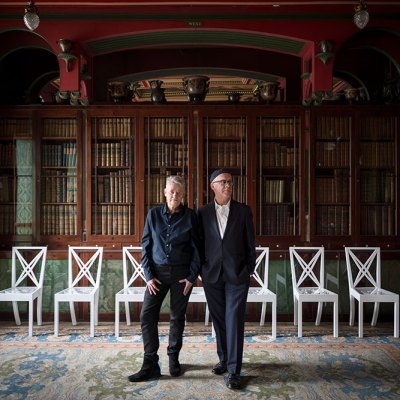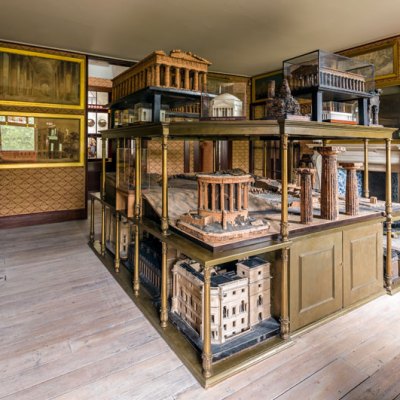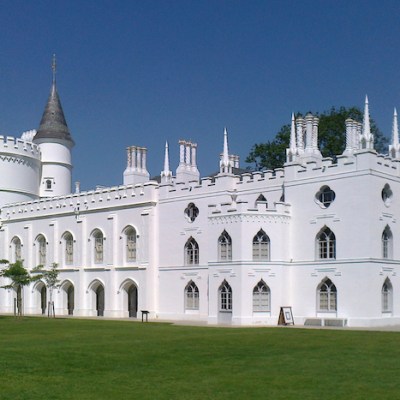The Bank of England appears as a fantastic ruin, sheared away at the corners, a Forum Romanum lashed from the west by the elements, illuminated from the north and with even its vaulted foundations laid bare. This is not an image of decay, however, but a triumphant depiction in the form of a cut-away perspective of the greatest architectural commission awarded in late Georgian London. John Soane became architect to the Bank in 1788 and from 1798 it became the task of the painter Joseph Gandy to memorialise and glorify the result – culminating with this visionary rendering in 1830.
Joseph Gandy, born 250 years ago this month, is the artist through whose imagination and remarkable facility we see the work of John Soane. From floor to ceiling, hinged panel by hinged panel, the principal rooms of Sir John Soane’s Museum in Lincoln’s Inn Fields are hung with Gandy’s painted renderings of the architect’s designs. They are frequently idealised and luminous reworkings of reality or, as time passed, more often representations of the elaborate scenography of Soane’s angry imagination – of the public commissions the architect should have been given.
On paper, Soane’s hand tended to be thin, hectic, even pedestrian; he drew to convey the essentials. Gandy’s freehand draughtsmanship, however, heightened by ecstatic colour and intense light effects and enlivened by narrative touches such as miniaturised workmen or family members, added an entirely new dimension to the finished perspectives.
Soane’s extensive commission in the mid 1790s for the country estate of banker William Praed at Tyringham, near Newport Pagnell, was to be one of the happiest and most successful of his career. He asked Gandy, only recently arrived in the office, to celebrate it. In a large rendering of the entrance and lodges, reduced to their powerful essentials in Soane’s stripped-down classicism, the gateway appears in a livid focus of storm light, turbulent clouds and diagonal shafts of rain overhead. Surrounding trees bow and toss in a frenzy under the elements. The funereal stillness of the architecture, the empty niches and a simple frieze of horizontal incisions binding the archway and the two tiny lodges, are a contrast in gravitas with the extraordinary turbulence around it.
View of the Entrance Lodge at Tyringham (1798), Joseph Gandy. Sir John Soane’s Museum, London. © The Trustees of Sir John Soane’s Museum
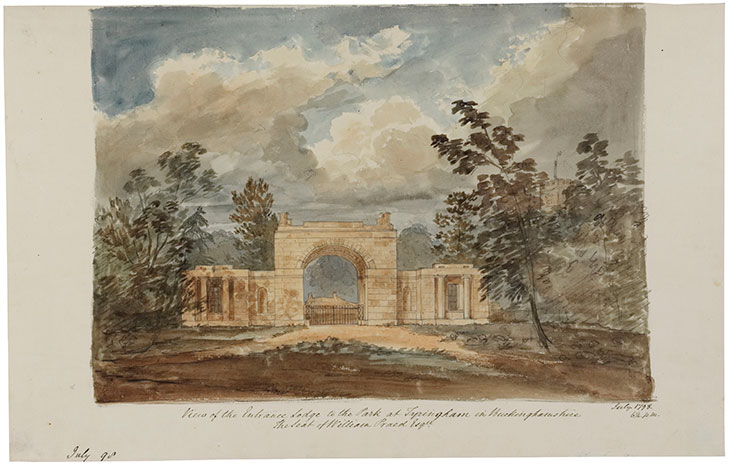
Gandy was almost 20 years Soane’s junior and may have reminded the architect of his younger self. Their backgrounds, early experience and travels followed a similar pattern. Gandy spent time in James Wyatt’s office, as Soane had in Henry Holland’s. After gaining silver and gold medals at the Royal Academy Schools Gandy travelled in Italy between 1794 and 1797, thanks to John Martindale, the owner of White’s Club in St James’s, where Gandy’s father was employed. But, as we know from Gandy’s letters to his father, his was not a conventional Grand Tour. He spent no less than seven hours in the Roman catacombs, with string and bran to guide his return, while the mausoleums of the Appian Way gripped his imagination, offering enduring evidence of an architecture of death and commemoration in classical antiquity. His delight in the park of Palazzo Chigi, Ariccia, and in the seasonal fireworks on Castel Sant’Angelo reveals a painterly eye, as does his vivid description of an eruption of Vesuvius.
Napoleon’s designs on Italy, along with the sudden financial crisis of his patron, drove Gandy back home. His hopes of becoming either an architect or painter of note were dashed – just as Soane’s had been after the Bishop of Derry inveigled him home early (also from Rome) with the promise of a major commission, only to renege on it. Men of modest birth should not expect favours from the upper classes, they had both learned.
Soane turned to Gandy for personal favours – to help burnish the hardly discernible talents of his son, John, and then, after he was widowed, to paint innumerable designs for his late wife Eliza’s tomb and suggest destinations for a lonely tour of northern England. As an architect, Gandy was an occasional, albeit intriguing, practitioner. He toyed with a move to America but instead in 1809 he briefly established a practice in Liverpool where the younger John Soane joined him.
The Tomb of Merlin (1815), Joseph Gandy. RIBA Collections, London
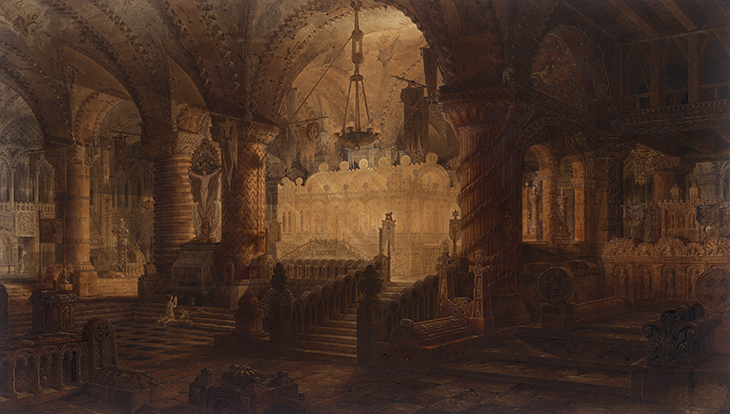
Among the most spectacular works exhibited on the walls of the Royal Academy in 1815 was Gandy’s The Tomb of Merlin, a mystical scene that draws the viewer into a glowing central core. In this case, Gandy was pursuing his own penchant for fantasy, architectural as well as literary, backed up by poetic quotations in the catalogue. But the glowing sepulchre also has recognisable elements of the 15th-century Rosslyn Chapel in Midlothian, Scotland, which Gandy had earlier measured and drawn for publication. There, as in the painting, one sturdy column is wreathed in vines, the so-called Apprentice Pillar. It is said to denote a Masonic myth of a workman who surpasses his master’s ability and is killed for it, an assistant who came to outperform his master. Perpetually hard-up, Gandy offered to sell The Tomb of Merlin to Soane, only to be refused. It was, we may surmise, a metaphor too far. As a painter of original scenes, Gandy favoured theatrical elements reinforced by fabulous, often encyclopaedic, detail but he was performing in a crowded field. His work was uneven and did not stand comparison with the consistently apocalyptic invention of John Martin and others.
Sometimes Soane and Gandy seem almost indivisible. Both men were intemperate characters and victims of feverish moods and fragile intellectual conceits, while being frequently at odds with others due to real or imagined slights. They shared ideas and even obsessions, but their correspondence is frustratingly fragmentary and generally dwells on Gandy’s perpetual financial troubles or crises due to his mental state. Crucially, however, he became the lens through which Soane could envisage, even magnify, his designs – now enriched, emboldened and even more compelling. Interiors at Lincoln’s Inn Fields began to take on the characteristics of Gandy’s paintings. The great Egyptian sarcophagus at the heart of the house – acquired by Soane in 1825 – became another Merlin’s tomb, its eerie glow emanating from the basement.
As Soane’s commissions became more contentious (as with the rebuilding of the Law Courts alongside Westminster Hall) and fewer clients came to the office, it became harder to discern which of the paintings of buildings exhibited at the Royal Academy represented fantasies, which reality. On one occasion, the painter C.R. Leslie recalled, the architectural room was entirely hung with ‘magnificent designs to which Sir John Soane’s name was attached’. Leslie noticed that Gandy’s name was not even mentioned in the catalogue, although Soane was losing his sight in old age. He died in 1837. Soon after, Joseph Gandy was confined to an asylum in Devon. He died there in 1843.
From the September 2021 issue of Apollo. Preview and subscribe here.
